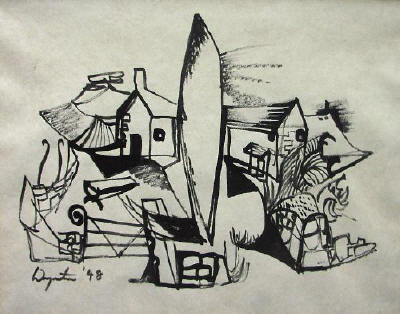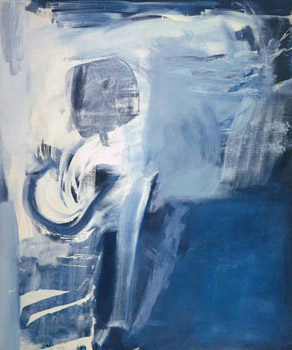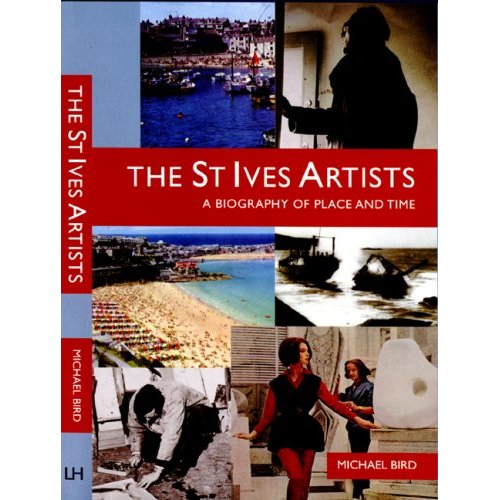|
|
| home | features | exhibitions | interviews | profiles | webprojects | gazetteer | links | archive | forum |
|
The St Ives artists : a biography of time and place Rupert White
As the golden era of St Ives art slips further from living memory, and as the town loses its original character, it becomes necessary to dig deeper - and try harder - to bring to life the spirit and energy of the modern movement, and the personalities that made it. Michael Bird, in his new book, 'The St Ives Artists: a biography of time and place' succeeds in doing so by showing the kind of obsessive eye for detail possessed by only the most dedicated fan. His love and devotion to St Ives and its artists permeates the book, which adds texture and fine-grained detail to the standard historical account, whilst sprinkling it with added spice in the form of gossip, speculation and anecdote.
This does not detract from the enjoyment of the book, however, given that Bird always intended to write a narrative, and to place that narrative within a wider context of the social changes occurring in Britain between 1930s and 1960s. It turns out to be a compelling and complex story, that, like the streets of St Ives itself, takes many detours despite only concentrating on 10 or so artists. The account begins in 1946 with Terry Frost arriving at the train station, penniless with his wife, before moving on to the 'discovery' of Alfred Wallis and the talismanic role he played in the early days of the modernist colony. 'For forty years the town had been full of painters: in all this time no one seemed to have asked any awkward questions about what art was for or what forms other than academic naturalism, it should take'. Bird relates in detail the Hampstead connection that linked a number of important figures immediately before the war, including Herbert Read, and why so many of these figures subsequently opted to move to Cornwall. The bohemian lifestyles of the second generation painters, eg Bryan Wynter (picture above), are conveyed vividly in the next chapter called 'Landscape with Wild Men'. According to Bird, they adopted 'a lifestyle that was not just mock primitive but actually so'. For Wynter 'Penwith's....exposure to the elements...seemed to connote the Freudian Id: source of the primal desires that Western civilisation sought to suppress'.
We go on to learn in detail about the general antipathy to modern art in wider British society as typified by caricatures in Kingsley Amis' Lucky Jim, and the fact that it was still linked in many peoples mind with a moneyed elite. To a degree, Bird concurs: 'How many painters in the history of St Ives could have disavowed the essential role played by private wealth in underwriting their art?' The next chapter describes the challenges to St Ives art that came from within the art world as well, first from John Berger, the Marxist critic and champion of realism, and later from Lawrence Alloway and the Independent Group. Patrick Heron, arguably more important as a critic than as an artist at this stage, responds initially by recruiting American abstract expressionism to the cause, though he is never fulsome in his praise for its artists: 'he seemed gripped by a perverse determination to feminise these thrusting, manly pioneers'. There is an interesting chapter dedicated to the female artists of the St Ives movement, particularly Sandra Blow and Wilhelmina Barnes-Graham. Bird then describes how the 1960s saw the St Ives artists going in new directions, Ben Nicholson moving to Switzerland, Wynter experimenting with mescaline and Lanyon taking up gliding (picture 'Thermal' above), only to be fatally injured. The final chapter is extremely poignant and details how Roger Hilton moved to Botallack in 1965, despite being settled, happy and successful in London, and there he apparently descended into alcoholism with his drinking partner, the poet Sydney Graham. Here, Bird's narrative approach works better than any more academic book could in bringing out the humanity and pathos in the relationship between the two men, summarised in the poem 'Lines on Roger Hiltons watch' 'which I was given because/I loved him and we had/terrible times together.
see interview with Michael Bird
http://www.amazon.co.uk/St-Ives-Artists-Biography-Place/dp/0853319561/ref=sr_1_1?ie=UTF8&s=books&qid=1208708715&sr=8-1
|
|
|


 There is a chapter on the formation of the
Penwith Society in St Ives, and the Festival of Britain in 1951. Bird
explains that this celebration of nationhood, to which a number of the
St Ives artists contributed, occurred at a time of austerity when
rationing was still in force and many of the buildings damaged during
the war remained derelict.
There is a chapter on the formation of the
Penwith Society in St Ives, and the Festival of Britain in 1951. Bird
explains that this celebration of nationhood, to which a number of the
St Ives artists contributed, occurred at a time of austerity when
rationing was still in force and many of the buildings damaged during
the war remained derelict. 